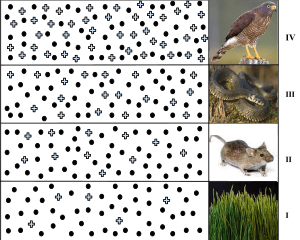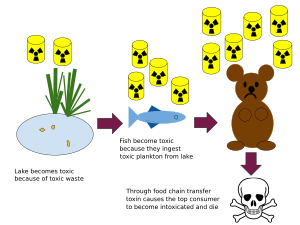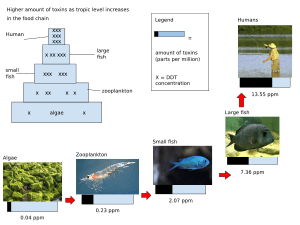Biomagnification facts for kids
Biomagnification, also called bioamplification or biological magnification, is when harmful substances, like certain chemicals or pesticides, become more and more concentrated in the bodies of living things as they move up the food chain. This means animals at the top of the food chain end up with the most of these harmful substances.
This increase happens for a few main reasons:
- Persistence: The substance doesn't break down easily in the environment. It stays around for a long time.
- Food Chain Movement: As one animal eats another, the harmful substance gets passed along. Since animals at higher levels eat many smaller animals, they collect more of the substance.
- Slow Removal: The bodies of living things can't easily get rid of these substances. They might not break them down or pass them out of their bodies, especially if the substances don't dissolve well in water.
Biomagnification often happens in water environments like lakes, rivers, and oceans. For example, tiny zooplankton might take in a small amount of a harmful chemical. Then, small fish eat many zooplankton, so the chemical builds up in the fish. Bigger fish then eat many small fish, getting even more of the chemical. This process continues up the food chain to large birds, animals, or even humans. The harmful substances become more and more concentrated in the tissues and organs of these animals.
Substances that build up in living things are called bioaccumulants. They increase in concentration because organisms take them in from contaminated air, water, or food, and their bodies are very slow at breaking them down or getting rid of them.
Contents
How Biomagnification Works
Starting Small: The Base of the Food Chain
Biomagnification usually begins with very small amounts of a harmful substance in the environment. This could be from pollution, like pesticides sprayed on farms that wash into rivers, or heavy metals from factories.
Tiny organisms, like plankton in water or small plants on land, absorb these substances. They might not be harmed much because the amount is so small.
Moving Up: From Prey to Predator
When a small animal, like a tiny fish or an insect, eats many of these contaminated tiny organisms, it takes in all the harmful substances from them. Since it eats a lot, the substance starts to build up in its body.
Then, a larger animal, like a bigger fish or a bird, eats many of these smaller contaminated animals. Each time it eats, it adds more of the harmful substance to its own body. This is why the concentration gets higher and higher at each step of the food chain.
The Top of the Food Chain: Highest Risk
Animals at the very top of the food chain, like eagles, bears, or even humans, are at the highest risk. They eat many animals that have already accumulated these substances. This means the harmful substances can reach very high and dangerous levels in their bodies.
For example, a chemical like DDT (a pesticide) can build up in fish. If an eagle eats many fish that have DDT, the eagle can end up with a very high concentration of DDT in its body. This can cause serious health problems for the eagle, like making its eggshells too thin, which harms its ability to reproduce.
Why Some Substances Biomagnify
Not all substances biomagnify. The ones that do usually share a few key features:
- Long-lasting: They don't break down easily in nature. They are "persistent."
- Fat-soluble: They dissolve well in fats and oils, but not in water. This means they can get stored in the fatty tissues of animals instead of being easily washed out of their bodies.
- Not easily removed: Animals' bodies have a hard time getting rid of them through waste or metabolism.
Because of these features, these substances stay in the environment and in living organisms for a long time, building up over time.
Impacts of Biomagnification
Biomagnification can have serious effects on wildlife and even humans.
- Wildlife Health: High levels of harmful substances can cause diseases, problems with reproduction, birth defects, or even death in animals. For example, mercury can affect the nervous system of birds and mammals.
- Ecosystem Balance: When top predators are affected, it can disrupt the entire ecosystem. If their populations decline, it can lead to an increase in their prey, which can then overgraze plants or other organisms.
- Human Health: Humans can also be affected by biomagnification, especially if they eat fish or other animals that have accumulated high levels of harmful substances. For example, eating too much fish with high mercury levels can be dangerous, especially for pregnant women and young children.
Understanding biomagnification helps us see how pollution in one part of the environment can affect living things far away and high up the food chain. It shows why it's important to control pollution and protect our planet.
See also
 In Spanish: Biomagnificación para niños
In Spanish: Biomagnificación para niños




